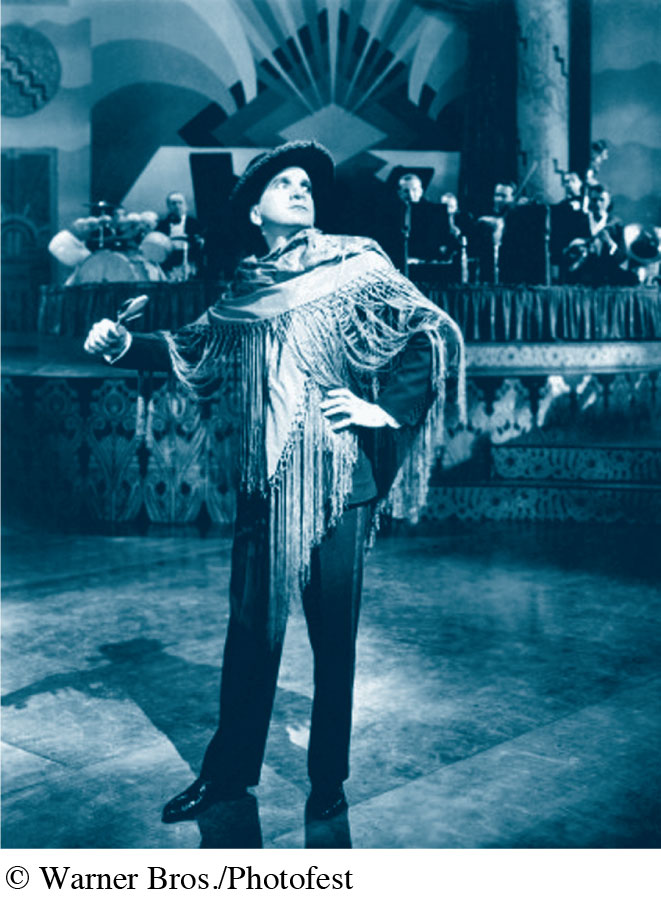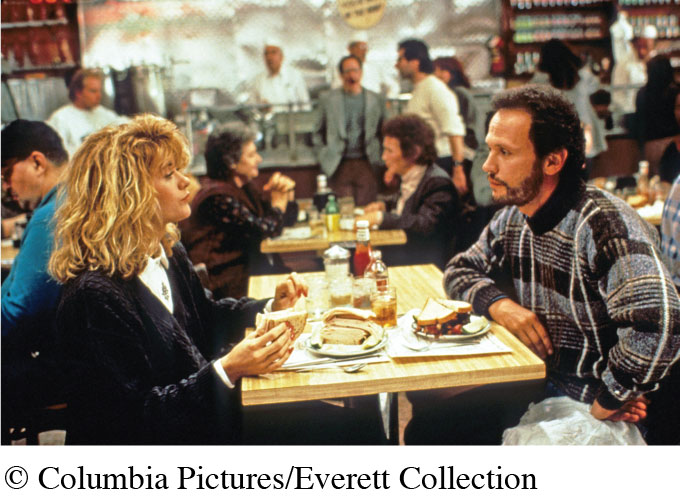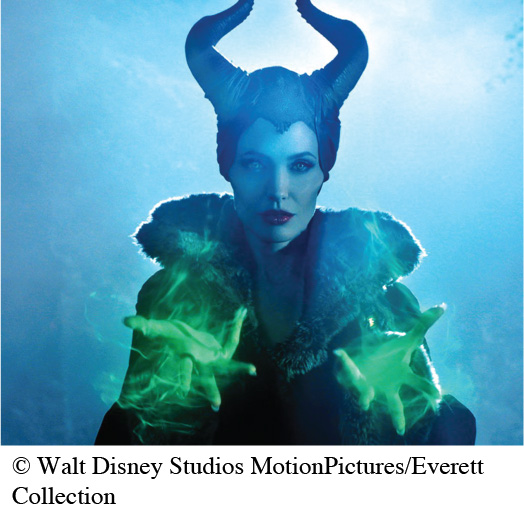Hollywood’s Golden Age: The Development of Style
Once the Hollywood studio system was established as a profitable business model, studios had the luxury of developing a distinctive moviemaking style that ultimately marked Hollywood’s Golden Age. This style began taking shape in 1915, characterized by the use of new narrative techniques (such as close-up camera shots and multiple story lines) in the silent era, the later introduction of sound, and the rise of movie genres. Hollywood’s monopolization of this style produced numerous films that have since become treasured classics. Yet during Hollywood’s Golden Age, other moviemaking models—including global cinema, documentaries, and independent films—provided alternatives to the classic style and shaped the medium just as powerfully.
228
Narrative Techniques in the Silent Era
Though telling stories in films occurred early on, moviemaking hit its stride as a viable art form when studios developed innovative narrative techniques, including the use of varied camera distances, close-up shots, multiple story lines, fast-paced editing, and symbolic imagery—even before sound was introduced. As these techniques evolved, making a movie became more than just telling a story; it became about how to tell the story. For example, the same sequence of events filmed from different camera angles could have totally different impacts on viewers.
D. W. Griffith, among the earliest “star” directors, used nearly all of these techniques at the same time in The Birth of a Nation (1915)—the first feature-length film (more than an hour long) produced in America. Although considered a technical masterpiece and an enormous hit, the film glorified the Ku Klux Klan and stereotyped southern blacks. The National Association for the Advancement of Colored People (NAACP) campaigned against the film, and protests and riots broke out at many screenings.
Other popular films created during the silent era were historical and religious epics, including Napoleon, Ben-Hur, and The Ten Commandments. But the era also produced pioneering social dramas, mysteries, comedies, horror films, science-fiction movies, war films, crime dramas, and westerns.
Augmenting Images with Sound

Hollywood’s Golden Age also saw the introduction of sound in 1927, which further established a distinctive narrative style and set new commercial standards in the industry. The availability of movies with sound pushed annual movie attendance in the United States from sixty million a week in 1927 to ninety million a week just two years later. By 1931, nearly 85 percent of America’s twenty thousand theaters accommodated talkies (sound pictures). And by 1935, the rest of the world had adopted talking films as the commercial standard.
Earlier attempts at creating talkies had failed; however, technical breakthroughs in the 1910s at AT&T’s research arm, Bell Labs, produced prototypes of loudspeakers and sound amplifiers. Experiments with sound continued during the 1920s, particularly at Warner Brothers. In 1927, the studio produced The Jazz Singer, a feature-length silent film interspersed with musical numbers and brief dialogue. Starring Al Jolson, a charismatic and popular vaudeville singer who wore blackface makeup as part of his act, the movie further demonstrated racism’s presence in the film industry. Warner Brothers’ 1928 release The Singing Fool, which also starred Jolson, became the real breakthrough for talkies. Costing $200,000 to make, the film raked in a whopping $5 million and “proved to all doubters that talkies were here to stay.”3
229

macmillanhighered.com/mediaessentials3e

Storytelling in Gravity
Visit LaunchPad to view a short clip from the Oscar-winning movie Gravity.
Discussion: Based on this clip, how does the movie seem to use advanced technical tools in service of classical studio-system storytelling?
Warner Brothers was not the only studio exploring sound technology. Five months before The Jazz Singer opened, Fox premiered sound-film newsreels (weekly ten-minute compilations of news events from around the world). Fox’s newsreel company, Movietone, captured the first film footage with sound of the takeoff and return of Charles Lindbergh, who piloted the first solo, nonstop flight across the Atlantic Ocean in May 1927. The Movietone sound system eventually became the industry standard.
Inside the Hollywood System: Setting the Standard for Narrative Style
By the time talkies had transformed the film industry, Hollywood had established firm control over narrative style—the recognizable way in which directors told stories through the movies they made. Hollywood had set the example for most moviemaking style worldwide, and continues to dominate American filmmaking style today. The model it developed serves up three ingredients that give Hollywood movies their distinctive flavor: the narrative (story), the genre (type of story), and the author (director). The right blend of these ingredients—combined with timing, marketing, and luck—has enabled Hollywood to create a long string of movie hits, from 1930s and 1940s classics like Gone with the Wind and Casablanca to recent successes like The Avengers and Gravity.
Hollywood Narratives



As we’ve seen, storytelling had long existed in movies, even in the silent era. But it was Hollywood’s Golden Age that saw the emergence of a distinctive narrative style that movie viewers soon associated with American filmmaking. Narrative always includes a story (what happens to whom) and discourse (how the story is told). Most movies feature a number of stories that play out within the film’s larger, overarching narrative. These narratives also present recognizable character types (protagonist, antagonist, romantic interest, sidekick) and have a clear beginning, middle, and end. The plot is usually propelled by the main character’s decisions and actions to resolve a conflict by the end of the movie. Nowadays, filmmakers also use computer-generated imagery (CGI) or digital remastering to augment narratives with special effects—providing a powerful experience that satisfies most audiences’ appetite for both the familiar and the distinctive.
230
Hollywood Genres
In addition to establishing a unique narrative style in its Golden Age, Hollywood gave birth to movie genres, categories in which conventions regarding characters, scenes, and themes recur in combination. Familiar genres include comedy, drama, romance, action/adventure, mystery/suspense, gangster, westerns, horror, fantasy/science fiction, musicals, and film noir (French for “black film”)—a genre developed in the United States after World War II that explores unstable characters and the sinister side of human nature.
Grouping films by category enabled the movie industry to achieve both product standardization (a set of formulas for producing genres) and product differentiation (a diverse set of movie-watching experiences for viewers to choose from).
Hollywood “Authors”

As another defining characteristic of Hollywood’s Golden Age, movie directors gained significant status. In commercial filmmaking, the director serves as the main “author” of a film. Sometimes called by the French term, auteurs, successful directors develop a particular cinematic style or an interest in specific topics that differentiates their narratives from those of other directors. During Hollywood’s Golden Age, notable directors included Alfred Hitchcock, Howard Hughes, Sam Goldwyn, and Busby Berkeley—each famous for his defining moviemaking style. Today, directors are just as distinctive: When you hear that a new movie is a “Spielberg film,” a “Tarantino project,” or “the latest from the Coen brothers,” you have a good idea of what to expect.
As the 1960s and 1970s unfolded, the films of Francis Ford Coppola (The Godfather), Brian De Palma (Carrie), William Friedkin (The Exorcist), George Lucas (Star Wars), Martin Scorsese (Taxi Driver), and Steven Spielberg (Jaws) signaled the start of a period that Scorsese has called “the deification of the director.” Through this development, a handful of talented directors gained the kind of economic clout and celebrity standing that had previously belonged to top movie stars. Though directors lost power in the 1980s and 1990s, the tradition carries on with well-known directors like Tim Burton, Quentin Tarantino, and Christopher Nolan.
231

macmillanhighered.com/mediaessentials3e

Breaking Barriers with 12 Years a Slave
Visit LaunchPad to view a short clip from the Oscar-winning movie from director Steve McQueen.
Discussion: How do you think 12 Years a Slave differs from previous depictions of black history in America?
Even today, most well-known film directors are white men. Only four women have ever received an Academy Award nomination for directing a feature film: Lina Wertmüller in 1976 for Seven Beauties, Jane Campion in 1994 for The Piano, Sofia Coppola in 2004 for Lost in Translation, and Kathryn Bigelow in 2010 for The Hurt Locker (she won). Directors from other groups have also struggled for recognition in Hollywood—and a few have become successful. Well-regarded African American directors include Kasi Lemmons (Black Nativity, 2013), John Singleton (Abduction, 2011), and Spike Lee (Red Hook Summer, 2012). (For more, see “Media Literacy Case Study: Breaking through Hollywood’s Race Barrier” on pages 234–235.) Asian Americans M. Night Shyamalan (After Earth, 2013), Ang Lee (Life of Pi, 2012), and Wayne Wang (Snow Flower and the Secret Fan, 2011) have also built accomplished directing careers.
Outside the Hollywood System: Providing Alternatives
Despite Hollywood’s dominance of the film industry, viewers have long had alternatives to the feature-length, hugely attended, big-budget movies offered by the studio system. These alternatives include global cinema, documentaries, and independent films.
Global Cinema

Films made in other countries constitute less than 2 percent of motion pictures seen in the United States today. Yet foreign films did well in 1920s America, especially in diverse neighborhoods in large cities. These films’ popularity has waxed and waned since the Great Depression, in response to such developments as assimilation of immigrants, postwar prosperity, and the rise of the home-video market.
To be sure, the modern success in the United States of movies like Crouching Tiger, Hidden Dragon (Taiwan, 2000), Amélie (France, 2001), and The Lives of Others (Germany, 2006) suggests that American audiences are willing to watch subtitled films with non-Hollywood perspectives. But foreign films have continued losing screen space to the expanding independent American film market. Today, the largest foreign-film industry is in India, which aficionados call “Bollywood” (a play on words combining Bombay and Hollywood). Bollywood produces as many as one thousand films every year, most of them romances or adventure musicals displaying a distinct style.
232
There are other avenues for U.S. audiences seeking access to international cinema. The Global Film Initiative, for example, selects and distributes an annual film series—Global Lens—to more than thirty-five locations in the United States, including many college campuses. Global Lens 2014 included films from Cameroon, Croatia, Egypt, India, Morocco, Russia, Rwanda, Turkey, and Venezuela.
Documentaries
Documentaries, through which directors interpret reality by recording real people and settings, evolved from several earlier types of nonfictional movies: interest films (which contained compiled footage of regional wars, political leaders, industrial workers, and agricultural scenes), newsreels, and travelogues (depictions of daily life in various communities around the world).
Over time, documentaries developed a unique identity. As educational, noncommercial presentations, they usually required the backing of industry, government, or philanthropy to cover production and other costs. By the late 1950s and early 1960s, the development of portable cameras led to a documentary style known as cinema verité (French for “truth film”). Portable cameras enabled documentarians (such as Robert Drew, for Primary, 1960) to go where cameras could not go before and record fragments of everyday life unobtrusively.
Perhaps the major contribution of documentaries has been their willingness to tackle controversial subject matter or bring attention to issues about which the public might not be aware. For example, Blackfish, a documentary by Gabriela Cowperthwaite released in 2013, tracks the tragic life of Tilikum, a captive killer whale that attacked and killed his trainer. The documentary examines the controversial practice of training orca whales for entertainment venues like SeaWorld. In fact, Blackfish, which first screened at the Sundance Film Festival, sparked anti-SeaWorld protests across the country. American documentary filmmaker Michael Moore often targets corporations or the government in his films, which include Fahrenheit 9/11 (2004), a critique of the Bush administration’s Middle East policies and the Iraq War, and Sicko (2007), an investigation into the flaws of the U.S. health-care system.
Independent Films
The success of some documentary films dovetails with the rise of indies, another alternative to the Hollywood system. As opposed to directors who work within the Hollywood system, independent filmmakers typically operate on a shoestring budget and show their movies in campus auditoriums, small film festivals, and—if they’re lucky—independent theaters. Successful independents like Kevin Smith (Clerks, 1994; Tusk, 2014), Darren Aronofsky (Black Swan, 2010; Noah, 2014), and Sofia Coppola (Lost in Translation, 2003; The Bling Ring, 2013) continue to find substantial audiences in theaters and through online services like Netflix, which promote work produced outside the studio system.
233
The rise of independent film festivals in the 1990s also helped Hollywood rediscover low-cost independent films as alternatives to the standard big-budget blockbuster types of movies. Big studios looked to these festivals as ways to find new talent, which sometimes led them to purchase independent film companies or set up deals to help with distribution for a cut of the profit. This feeder system has since declined due to a poor economy, waning interest by major studios, and indies taking greater advantage of digital distribution models, though many indie directors of the 1990s—such as David O. Russell (American Hustle, 2013) and Alexander Payne (Nebraska, 2013)—have also found success at the big studios.